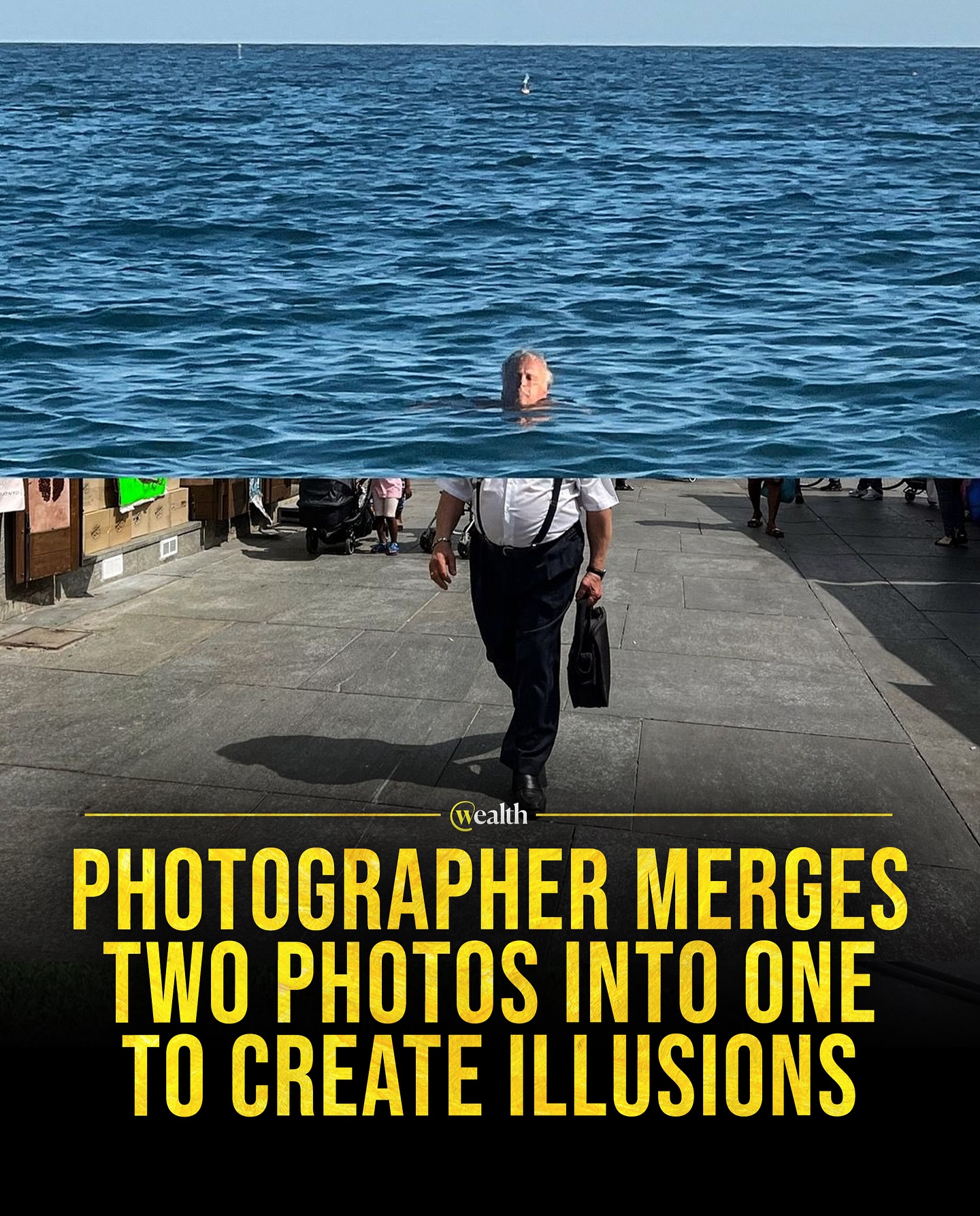Meet the Artist Who Fuses Two Ordinary Photos Into One Seamless Illusion — Turning Everyday Scenes Into Mind-Bending Works of Art That Challenge What You See
There are moments when a photograph makes you pause — not because it’s beautiful in the traditional sense, but because your brain refuses to make sense of what it’s seeing. That’s exactly the feeling evoked by the surreal creations of Italian photographer and digital artist Giuseppe Fontanesi, whose optical illusions have quietly taken the art world and social media by storm. His technique is deceptively simple: take two unrelated photographs, slice them precisely along a shared line, and align them so seamlessly that the border disappears. The result is a single image that lives in two realities at once — half fact, half dream, and entirely mesmerizing.

Fontanesi’s works make you question everything you think you know about photography. In one piece, a calm ocean stretches infinitely into the horizon, but below the surface, a businessman strolls down a cobblestone street, the waves cutting across his chest like a second sky. In another, a tranquil forest floor gives way to a busy crosswalk, and the meeting point between them feels oddly natural, as if both worlds were always meant to coexist. Each image feels impossible but believable, like a glitch in reality that only your eyes can see.
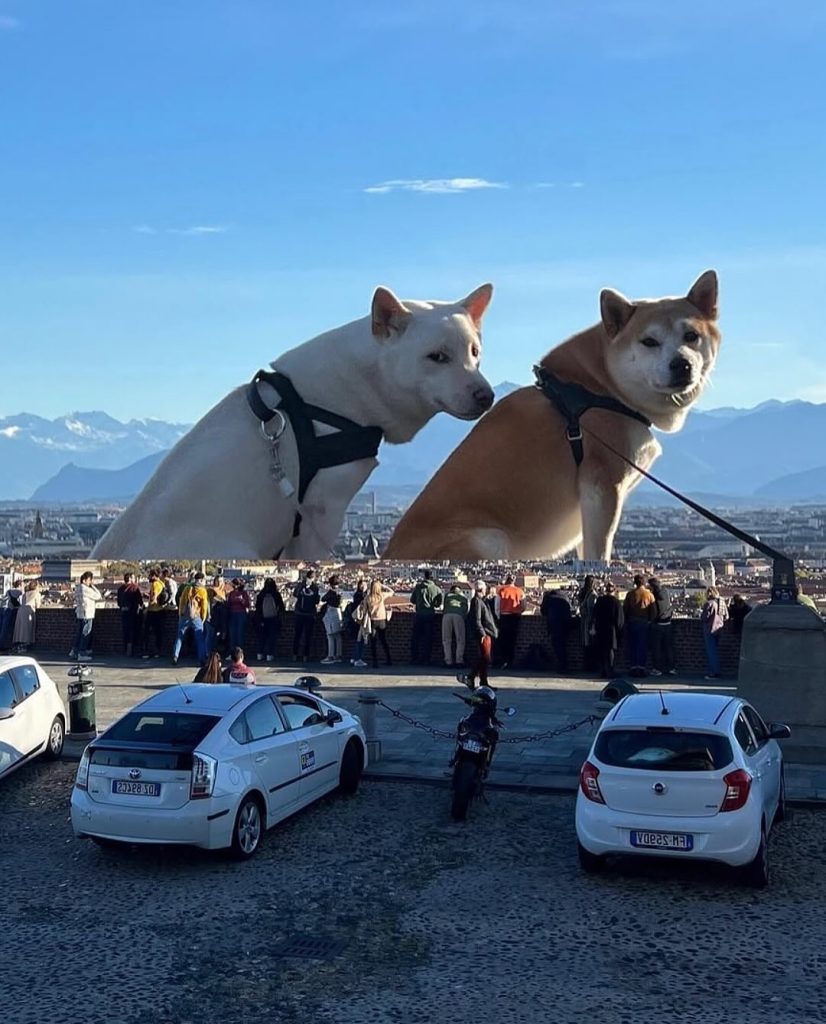
The artist’s process is as meticulous as it is imaginative. Using his camera, Fontanesi captures ordinary scenes — city streets, skies, seascapes, highways, parks — always searching for textures and lighting that might eventually align. “It’s not about editing one photo,” he once explained in an interview. “It’s about seeing how two different worlds can talk to each other.” After choosing his pair of images, he digitally trims them along a clean, perfectly straight seam, often at the horizon line or where light naturally shifts. Then comes the most delicate step: merging. By carefully matching shadows, tones, and perspective, he creates a unified illusion that tricks the brain into merging what it knows with what it perceives.
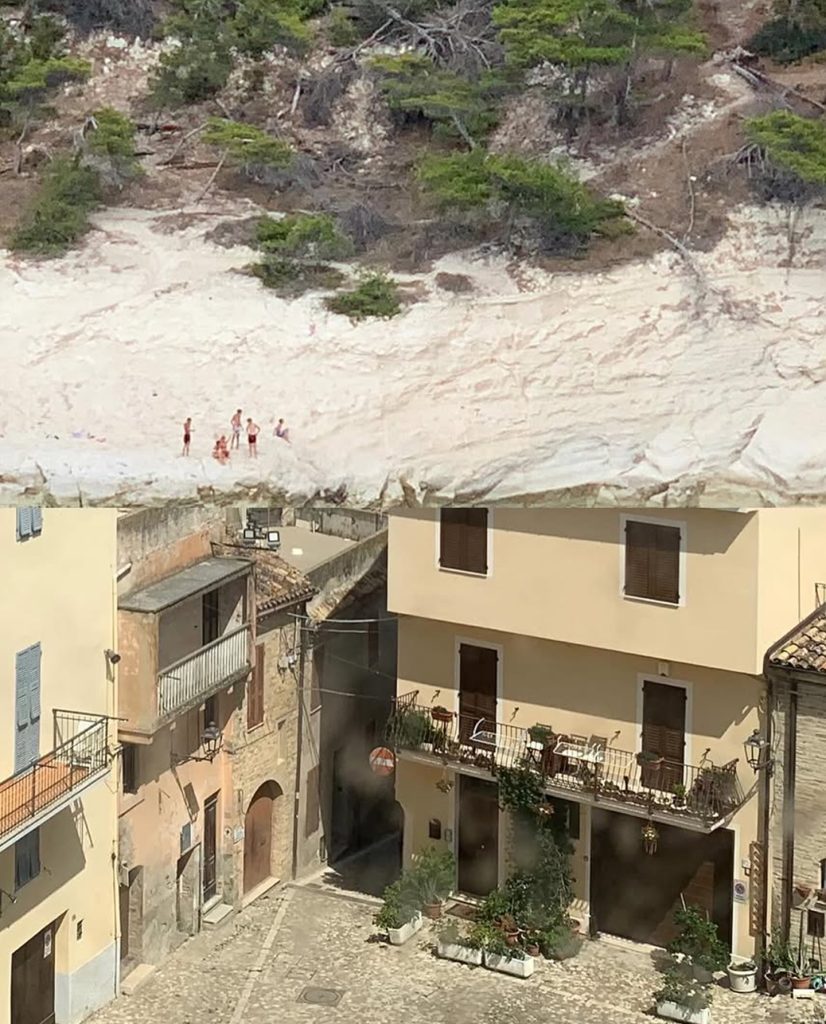
The beauty of Fontanesi’s work is that it doesn’t rely on heavy digital manipulation or artificial enhancement. Instead, it’s rooted in observation — the kind of attention to detail that photographers spend years cultivating. What makes his illusions so powerful is how effortlessly they feel real. He’s not painting fantasy worlds or using CGI; he’s showing us that surrealism already exists, hidden in plain sight, waiting for the right perspective to reveal it.
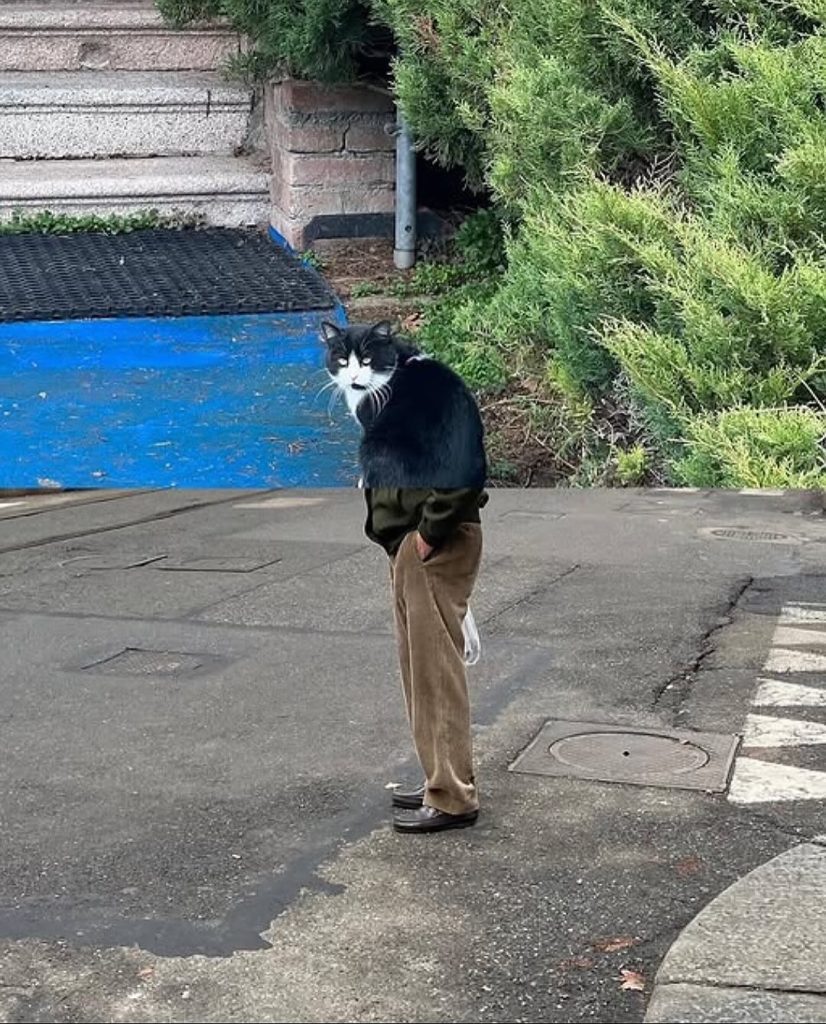
Each image has a sense of quiet poetry, even when it plays with contradiction. A man walks underwater without gasping for air. A building pierces through clouds that might just be dust. A river turns into a sky, and a sky into a sidewalk. In these moments, Fontanesi transforms everyday spaces into portals — not through fantasy, but through precision and empathy. The viewer becomes both participant and observer, drawn into an illusion that feels strangely familiar yet disorienting.
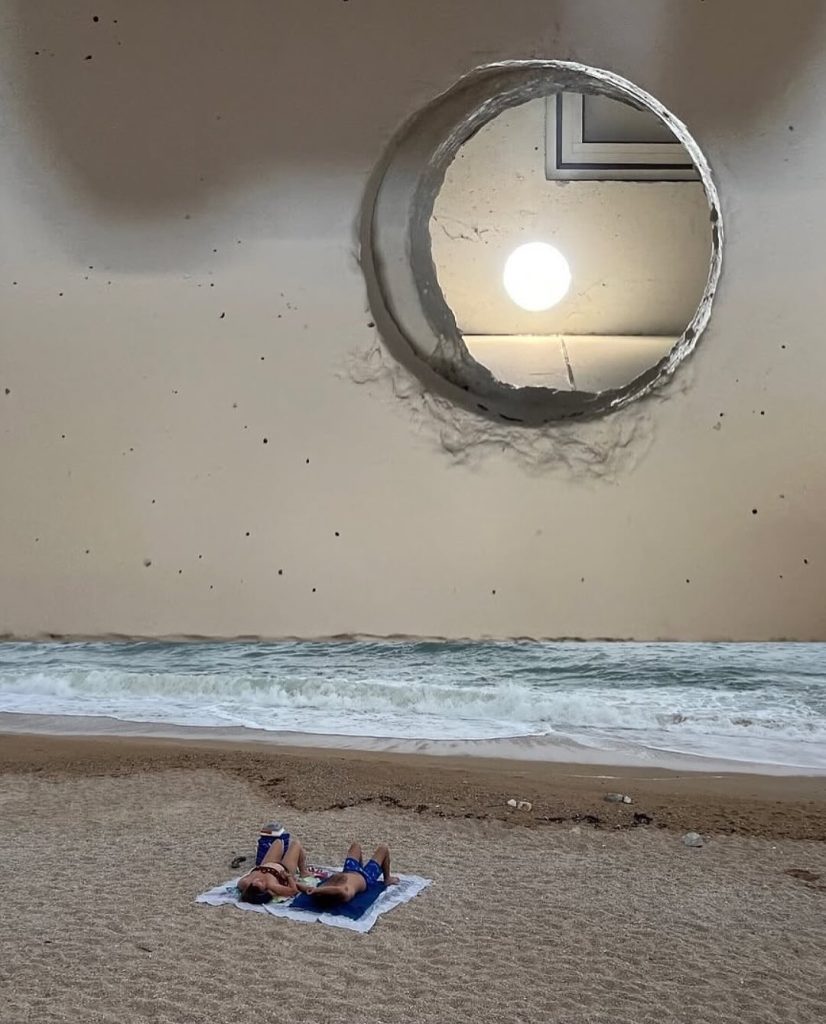
Art critics have described Fontanesi’s pieces as “visual haikus” — brief, simple compositions that capture something vast and elusive. Like poetry, they rely on rhythm and balance, using the harmony between two contrasting halves to create a complete emotional experience. They don’t demand explanation. They simply invite reflection.
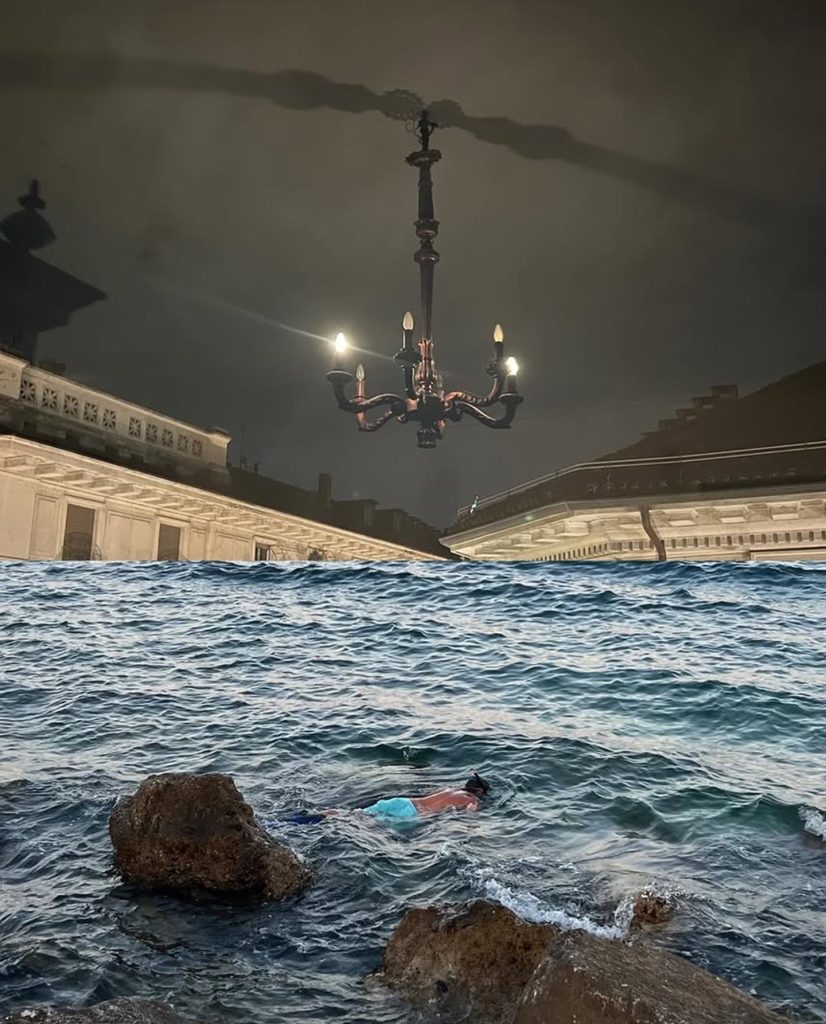
In an age dominated by over-edited digital art and AI-generated visuals, Fontanesi’s approach feels refreshingly human. Every illusion he creates carries the imperfections of real light, the unpredictability of weather, the subtle variance of natural color. It’s this authenticity that keeps his work grounded. You can feel the air in his images, the warmth of sunlight, the density of ocean water. The illusion may fool your eyes, but it never loses its emotional truth.
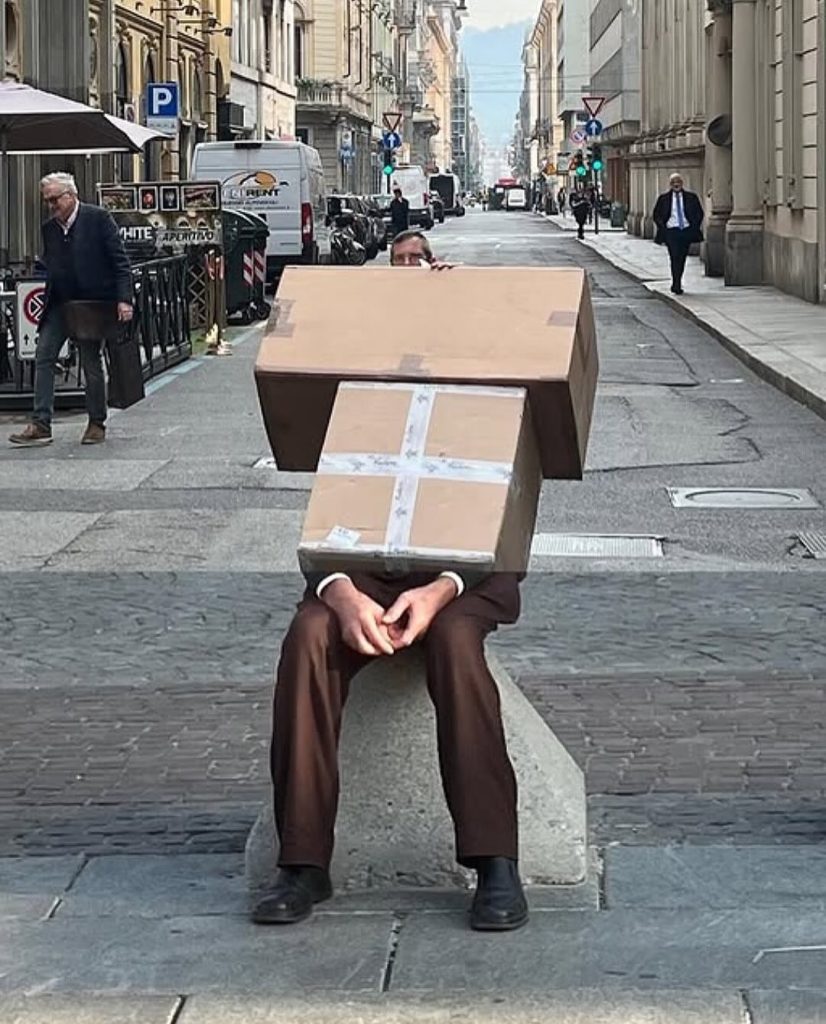
Fontanesi’s rise in the online art community was organic. His early experiments began as personal projects during long walks through his hometown, where he photographed random details — walls, reflections, horizons — without any particular purpose. One evening, while reviewing his shots, he noticed that two separate photos shared nearly identical vanishing points. On a whim, he combined them, aligning the lines where they met. The result stunned him. “It looked wrong, but right at the same time,” he later said. “I couldn’t stop staring at it. That’s when I realized what I wanted to explore.”
Since then, his illusionary series has evolved into a distinct body of work that’s been featured in international art exhibitions and design magazines. Collectors and critics alike have praised his ability to bridge the divide between photography and visual storytelling. His creations remind people that art doesn’t always need to invent something new — sometimes it just needs to rearrange what already exists.
Fontanesi’s audience has also grown beyond traditional art circles. On platforms like Instagram and Reddit, his posts often go viral within hours, shared by people who can’t decide if they’re looking at Photoshop trickery or pure genius. Comment sections fill with debates and double takes — “Wait, is that water or sky?” “Why does this feel real?” “I can’t unsee it now.” That’s the essence of his magic: he gives you just enough logic to believe, and just enough impossibility to wonder.
Behind his minimalist compositions lies a deeper commentary about perception itself. Fontanesi’s illusions remind us that photography, often thought to be a mirror of truth, can also be a mirror of imagination. What we see isn’t always what’s there — and what’s there isn’t always what we see. It’s a subtle but powerful message in an era when digital manipulation often blurs the line between reality and fabrication.
What makes his work even more intriguing is its restraint. Fontanesi doesn’t rely on surreal subjects or abstract chaos. He works with simplicity — clean lines, familiar settings, natural colors. It’s this simplicity that heightens the illusion. Our minds crave patterns, and when we see something that almost fits those patterns, we fill in the rest. That’s why his compositions are so effective. They don’t shout; they whisper. They let your brain do the work, and in doing so, they reveal how fragile perception can be.
Critics have compared Fontanesi’s work to that of artists like René Magritte, whose surreal paintings questioned the boundaries of logic and visual truth. But unlike Magritte’s philosophical surrealism, Fontanesi’s art feels grounded in modern experience — the way our eyes flicker between screens, reflections, and split-second moments of confusion. His illusions mirror the fragmented way we now see the world: part real, part constructed, always overlapping.
Beyond their visual trickery, the images evoke emotion — a quiet tension between two realities. The ocean becomes a metaphor for weight and depth; the street below, for routine and movement. Together, they form a visual dialogue about the duality of human life — the calm and the chaos, the surface and what lies beneath. “I think that’s why people connect with them,” Fontanesi once said. “They feel something before they understand it.”
Even his technical approach carries artistic meaning. The seam — that invisible line where two images meet — is symbolic of the invisible boundaries in our lives: between work and rest, dreams and duty, the physical and the emotional. The perfection of the merge isn’t about hiding the line; it’s about what the line represents — the point where different realities coexist without conflict.
As his reputation grows, Fontanesi remains humble about his process. He sees himself not as a manipulator of images, but as a translator of perspectives. “I just show what’s already there,” he says. “The world is full of illusions. I just connect them.” That philosophy echoes through every piece he makes, inviting viewers to slow down and look again — not just at his work, but at the world around them.
What’s fascinating is how universal his illusions feel. Whether you’re an artist, a photographer, or simply someone scrolling through your feed, you can’t help but engage with them. They force a pause — a rare moment in the constant flood of digital imagery where your eyes stop scanning and start thinking. That alone makes Fontanesi’s art quietly revolutionary in an era defined by distraction.
Ultimately, Fontanesi’s photographs remind us that reality is never just one picture. It’s a composite — of moments, emotions, perspectives — all stitched together in ways we rarely notice. His art captures that truth with elegant precision, proving that sometimes, the most powerful illusions aren’t the ones that trick us, but the ones that reveal how easily we can be tricked.
In a world oversaturated with images, Giuseppe Fontanesi has found a way to make people look again — and more importantly, to see. His seamless merges blur the boundary between imagination and observation, between what’s real and what’s possible. And in that delicate seam, where sky meets sea and streets meet waves, he invites us to find our own reflection — half in one world, half in another, suspended beautifully in between.

